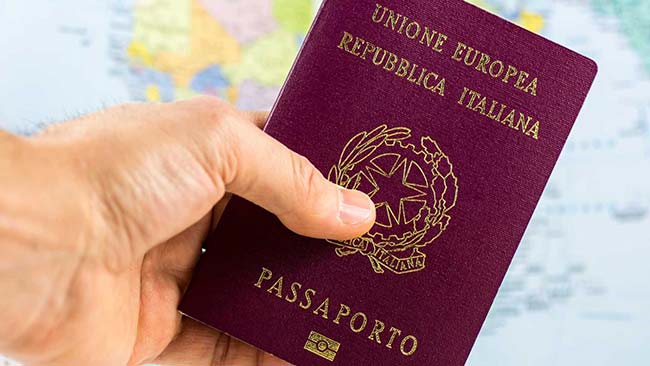By some estimates there are 16 million people of Italian heritage in the United States alone, not to mention the Italian diaspora in South America, Australia, Canada, and the UK.
Due to Italy’s favourable citizenship laws towards those of Italian descent, most of them qualify for an Italian passport.
For those seeking to live, work, or study in Italy and the European Union, an Italian passport is a game-changer.
While some dream of living la dolce vita, those who qualify for Italian citizenship can actually do it.
In this post, we explain what Italian dual citizenship is, how you can qualify, why you might want to, and how you can obtain your actual Italian passport.
Andiamo!
Article Chapters
How does Italian citizenship work?
According to Law no. 555 of 1912, Italian citizenship is passed down from parent to child.
Being born in Italy is not enough to obtain Italian citizenship.
You are only an Italian citizen by birth if at least one of your parents is Italian.
This system is known as jure sanguinis—a Latin term meaning “by right of blood.”
Many European countries operate on a jure sanguinis basis.
Contrast this with jure soli countries like the United States and Canada.
In jure soli countries, you are automatically a citizen as long as you are born in that territory.
There, the citizenship of your parents has no bearing on your nationality.
The two systems—jure sanguinis and jure soli—can co-exist.
In fact, one can be a citizen of the United States jure soli and a citizen of Italy jure sanguinis.
That is how many people moving to Canada from the UK, Australia, the US and beyond qualify for Italian citizenship.

Italian Law Takes ‘Jure Sanguinis’ Even Further
Possibly alone in the world, Italy allows jure sanguinis citizenship to pass on indefinitely.
This means that as long as Italian citizenship is successfully handed down just one time from parent to child, it’s subsequently passed down from generation to generation without limit.
What’s more, each generation does not need to get their own Italian citizenship recognised for it to be valid.
It can sit there, waiting to be claimed, across any number of generations.
In this manner, people who have an Italian grandparent, great grandparent or even great-great grandparent can still qualify for Italian citizenship themselves as long as they meet all the criteria.
How to Qualify for Italian Dual Citizenship
Qualifying is as simple as understanding a few key rules.
You must meet every one of them in order to be eligible.
- Your Italian ancestor must have been alive, anywhere in the world, on or after March 17, 1861.
Before this date, there was no such thing as Italy. People born in (most of) the territory we now call Italy got their Italian citizenship automatically on this date. Therefore, if your ancestor died before then s/he never actually held Italian citizenship and could not pass it on. - Your Italian ancestor was still an Italian citizen at the time of his/her child’s birth.
This means that your ancestor must not have become a citizen of another country by the time his or her child was born. Becoming a citizen of another country would have caused your ancestor to immediately lose Italian citizenship. Thus, s/he could not pass it on. - If your Italian ancestor ever did become a citizen of another country, it must have been both after the birth of his or her child, and after July 1, 1912.
This date is important because it’s when Law no. 555 of 1912 came into effect. Any Italian losing citizenship before then could not pass it on, even if the loss occurred after the birth of his/her child. - If there are women in your direct line, their child must have been born on or after January 1, 1948.
Before this date women could not pass on citizenship to their children, except where fathers were missing, deceased, unknown, or their own foreign citizenship didn’t pass down. It is worth noting that many people have successfully challenged this rule in court (more on this below).
A Few Practical Examples
- John was born in the United States in 1947. His father Jack was born in the United States in 1924. Jack’s father Francesco was born in Italy in 1901. Francesco became an American citizen in 1923. Because Francesco was not an Italian citizen at the time of Jacks’ birth, neither Jack nor his son John qualify for Italian citizenship.
- Jack has a brother Gregory who was born in the United States in 1921. Because Francesco was still an Italian citizen in 1921 at the time of Gregory’s birth, both Gregory and all of his descendants qualify for Italian dual citizenship.
- Ursula was born in Canada in 1957. Her father Pietro was born in Canada in 1932. Pietro’s mom Giacinta was born in Italy in 1903. Because Pietro was born before January 1, 1948, he did not obtain Italian citizenship from his mom and he cannot pass it down to Ursula either. Pietro will have to see if his father qualifies him or he’ll have to take his case to court.
When to Take It to Court
If you have women in your direct line with children born before January 1, 1948 you may still be able to qualify.
Since 2009, Italian courts have consistently ruled this discrimination unconstitutional.
However, it has not yet been enshrined in law.
This means that those falling under this category cannot apply through the normal administrative channels which we will detail below.
These applicants must hire an Italian attorney to represent them in Rome.
There is good news, however: these cases have a high probability of success.
Benefits of Italian Dual Citizenship
Obtaining your Italian citizenship brings many benefits. Here are just a few of them:
- Italian citizens can live, work, and study anywhere within the European Union.
- You can enjoy world class healthcare. Italy’s healthcare system consistently ranks in the top 3 worldwide every year.
- You can enjoy affordable education and send yourself of your children to school without debt.
- Italian citizens can purchase property in Italy with far less overhead than foreigners.
- When you’re abroad, you’ll be protected by two embassies.
- It’s a tangible way of honoring your heritage.
- If you are seeking employment, your dual citizenship makes you both more mobile and more attractive to employers.
- You can pass it on to your children and spouse.
Where to Apply for Italian Dual Citizenship
From Outside Italy
If you are living outside Italy, you must file your application at the Italian consulate which has jurisdiction over your place of residence.
Most consulates operate with an online appointment booking system called “Prenota.”
From their website, you can select a calendar date.
However, note that in many countries Italian dual citizenship is quite popular.
It is not unheard of to wait a few years just for the appointment.
After the appointment, the Italian government has 24 months to process your application.
From Inside Italy
If you live in Italy, you will apply at your comune (town).
First, you’ll apply for residency at the ufficio anagrafe.
Once that’s done, you will then apply for citizenship either at the ufficio di stato civile or the ufficio di cittadinanza.

What Documents You’ll Need
In order to successfully stake your claim of citizenship, you need to gather documentation.
This includes vital records such as birth, death, marriage, and naturalization certificates to recreate your family tree.
As a general rule, you will need the following:
For You
- Your birth certificate, translated into Italian and legalized with an apostille
- Your marriage certificate, translated into Italian and legalized with an apostille
For Your Parent
- His/her birth certificate, translated into Italian and legalized with an apostille
- His/her marriage certificate, translated into Italian and legalized with an apostille
- Any applicable death certificate, translated into Italian and legalized with an apostille
For Any Subsequent Generations Between You, Your Parents, & Your Italian Ancestor
- His/her birth certificate, translated into Italian and legalized with an apostille
- His/her marriage certificate, translated into Italian and legalized with an apostille
- Any applicable death certificate, translated into Italian and legalized with an apostille
For Your Italian Ancestor
- Your ancestor’s Italian birth certificate
- His/her naturalization certificate or proof of non-naturalization, translated into Italian
- His/her marriage certificate, translated into Italian and legalized with an apostille
- Any applicable death certificate, translated into Italian and legalized with an apostille
If you feel you cannot handle obtaining documentation on your own, there are Italian dual citizenship companies which can help.
How Much Does It Cost?
You can expect to spend 300 euros on the application fee itself (if you apply outside Italy).
Other than that, your costs may range from a few hundred to a few thousand depending on how many documents you must obtain.
Conclusion
If you qualify, Italian dual citizenship is your birthright.
In fact, those who qualify are not actually applying for citizenship at all – they are merely asking the Italian government to recognise a status they already hold.
If you have the time and energy, putting together your application for citizenship is highly doable and brings with it numerous benefits.

